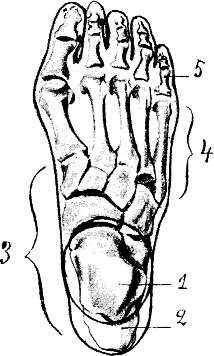Hallux rigidus
Hallux rigidus is a medical condition characterized by stiffness and pain in the metatarsophalangeal joint (MTP) of the big toe. It is a form of degenerative arthritis and can significantly impact a person's ability to walk and engage in physical activities.
Signs and Symptoms[edit | edit source]
The primary symptoms of hallux rigidus include:
- Pain and stiffness in the big toe, especially during walking or standing.
- Swelling and inflammation around the MTP joint.
- Difficulty in bending the big toe.
- Development of bone spurs on the top of the MTP joint, which can lead to a bump that is painful and limits shoe wear.
Causes[edit | edit source]
Hallux rigidus is often caused by wear and tear of the joint over time. Factors that may contribute to the development of this condition include:
- Osteoarthritis.
- Previous injury to the big toe.
- Abnormal foot anatomy or biomechanics.
- Genetic predisposition.
Diagnosis[edit | edit source]
Diagnosis of hallux rigidus typically involves:
- A physical examination of the foot.
- X-ray imaging to assess the extent of joint degeneration and the presence of bone spurs.
- Magnetic resonance imaging (MRI) or computed tomography (CT) scans in more complex cases.
Treatment[edit | edit source]
Treatment options for hallux rigidus vary depending on the severity of the condition and may include:
- Non-surgical treatments:
- Nonsteroidal anti-inflammatory drugs (NSAIDs) to reduce pain and inflammation.
- Physical therapy to improve joint mobility.
- Custom orthotic devices to support the foot and reduce stress on the MTP joint.
- Shoe modifications, such as stiff-soled shoes or shoes with a large toe box.
- Surgical treatments:
- Cheilectomy: Removal of bone spurs and part of the foot bone to improve joint movement.
- Arthrodesis: Fusion of the MTP joint to eliminate pain by preventing joint movement.
- Arthroplasty: Joint replacement surgery to restore function and relieve pain.
Prognosis[edit | edit source]
The prognosis for individuals with hallux rigidus varies. Non-surgical treatments can often manage symptoms effectively, but in severe cases, surgery may be necessary to restore function and alleviate pain. Early diagnosis and treatment are crucial to prevent the progression of the condition.
Prevention[edit | edit source]
Preventive measures for hallux rigidus include:
- Wearing appropriate footwear that provides adequate support and room for the toes.
- Avoiding activities that place excessive stress on the big toe.
- Maintaining a healthy weight to reduce pressure on the feet.
- Performing regular foot exercises to maintain joint flexibility and strength.
See Also[edit | edit source]
References[edit | edit source]
External Links[edit | edit source]
Navigation: Wellness - Encyclopedia - Health topics - Disease Index - Drugs - World Directory - Gray's Anatomy - Keto diet - Recipes
Search WikiMD
Ad.Tired of being Overweight? Try W8MD's physician weight loss program.
Semaglutide (Ozempic / Wegovy and Tirzepatide (Mounjaro / Zepbound) available.
Advertise on WikiMD
WikiMD is not a substitute for professional medical advice. See full disclaimer.
Credits:Most images are courtesy of Wikimedia commons, and templates Wikipedia, licensed under CC BY SA or similar.Contributors: Prab R. Tumpati, MD

